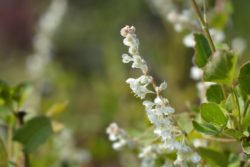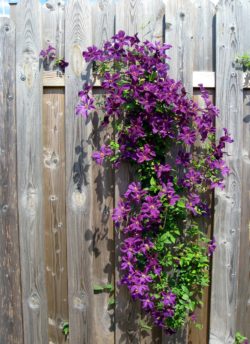Perfect Vines and Plants for Pergolas and Trellises
Covering your pergola or trellis with plants is a decorative way to embellish your outdoor living space with greenery, color and even fragrance. With a pergola, the plants will protect you from the harsh rays of the sun – in time – as well as camouflage any nearby neighbor’s view! While it’s hard to choose from among the plants that grow quickly and thrive in Colorado’s climate, here are a few climbing options for our Zone 5 summers and winters. (Many thanks to the Denver Post for its expert advice below!)
Climbing Vines Suited for Colorado
1. Passion Flower (Passiflora incarnata). Showy, purple flowers get hummingbirds to hang around your garden, happily visiting the blooms covering the vine. The lobed, deep green leaves provide a backdrop that makes the flowers pop.

Size: To 25 feet long
Zone: 5a
How: Plant in a protected site, mulching thickly to protect the roots while the top dies down to the ground during the winter. Passion Flower spreads via roots, so if you’d like to contain it, plant in a large container and move it into the garage for the winter.
2. Five-leafed Akebia (Akebia quinata). Delicate leaves made up of five-leaflets make this an unusual vine for jazzing up your landscape. The lightly scented flowers hang in pendulous clumps.

Size: 20 feet long or more
Zone: 5a
How: Pop this climber in full sun to light shade; it won’t fruit here, says Murgel. But it will ramble up a tree, so periodically loosen it to ensure that it doesn’t girdle branches.
3. Honeysuckle (Lonicera species) is a favorite of Murgels’, since they’re showy all summer and attract hummingbirds. Look for the Blanche Sandman variety, a showstopper wreathed in pink-orange blossoms with golden throats.

Size: 20 feet
Zone: 5a
How: Full sun, even moisture and something to climb are all that it takes to grow Blanche Sandman. Once established, keep it tidy by an occasional light pruning after the danger of hard frost has passed.
4. Wisteria (Wisteria). Classic, elegant wisteria (Wisteria species) drapes deep purple flowers on a woody, long-lived vine. Perfumed and showy, wisteria needs permanent support, such as a dramatic arbor or doorway arch.

Size: 30 feet
Zone: 5
How to grow: Because the flower buds swell early, put wisteria in a protected location to keep late frosts from nipping blossoms. Once established, prune them twice per year: a light pruning in midsummer to remove wispy growth and a hard pruning back to two buds per branch in winter. Don’t let them dry out.
5. Silver Lace Vine (Polygonum aubertii). If you have a large area that needs screening quickly, try this rampant, sweet- smelling vine. The sprays of white blossoms that coat the plant from summer to fall reach to 6 inches long.

Size: 20 to 30 feet
Zone: 5
How to Grow:
Silver lace vine care is easy, as these adaptable plants require very little care once established and are not overly picky about the soil they are grown in. However, this vine can quickly become invasive unless growth is restricted or contained on a self-standing arbor or fence.
Give this plant a sturdy support in a carefully chosen area, as it can easily swallow small arbors or trellises.
6. Clematis (Ranunculaceae) is a beautiful flowering vine that wins a lot of popularity contests. And while there are different varieties of clematis, the experts at Tagawa Gardens favor two bright blue and purple favorites, the Jackman and the Polish Spirit. Both have bright-colored purple (one royal, one rich) flowers and are nearly indestructible. And if you’ve never grown a clematis before, this would be a great variety to start with!

Size: 10 feet tall and 24 inches wide
Zone: 5
How to Grow: Keep the roots cool by mulching them well. These clematis should be watered to a depth of three inches each week, but make sure the top two inches are dry before watering it again. In extreme heat, it may need to be watered twice a week. Again, when it rains, stop watering. They need full or partial sun to survive and thrive.
Training vines to climb takes very little effort, but is sometimes necessary for climbers that need a little nudge. Get Busy Gardening has tips you can follow to train your plants using nails, string, twist ties and plant clips.
Grape Vines in Colorado

Grapes are a yummy summer fruit and if you plant grape vines, you can even use the wrappers to make stuffed grape leaves! But one caution before you plant your favorite vintage, grape vines can grow up to 115 long. And if you want your vines to produce grapes, pruning is a must. For the first couple years of their lives, a grape vine will need about an inch of water a week, depending on rain. But older vines rarely need to be watered. They also do best with a full day of sun and will produce less fruit with less light.

Before planting grapes, figure out just what you want to do with them. Are you a home chef who’d like to make jam? Wine? Or just have them ripen for the family to eat fresh off the vine? Different grapes are grown for different reasons.
Zone 5 grape varieties include Concord, Fredonia, Gewurztraminer, Niagara, and Catawba. There are many other cultivars suited to zone 5, but these are some of the most popular.

Concord grape is associated with grape jelly and juice and is also good eaten fresh. Fredonia is a hardier version of Concord and ripens earlier. Gewürztraminer makes a lovely rich, full-bodied wine and is one of the hardiest of the commercial white wine grapes. Niagara is very popular and noted for its delicious green table grapes. And Catawba is a very sweet red grape that is used to make sweet or sparkling wines.
Backyard Beauty on the Hill!

It’s time to get growing in the master-planned community of Colliers Hill a new home community in Northern Colorado with plenty of recreational options, exciting amenities and beautiful model homes from KB Home, Century Communities and Richmond American Homes. It’s still a great time to buy a home priced from the high $300s – without crazy competition and frustrating bidding wars! Come and find out why life is better on the Hill!


